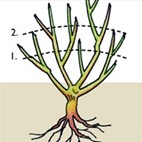Together We Can Stop Crape Murder
Killing of the Crapes is a disturbing phenomenon that runs rampant every winter in the southern states. The good news is, these unfortunate practices can be stopped! Together, with our trusty pruners and knowledge from our professional landscapers, we can eliminate Crape Murder! Lagerstroemia indica, also known as the Crapemyrtle and fondly called the “Lilac of the South,” is actually a native of China. In 1786 is was introduced in South Carolina by Frenchman Andre Michaux. This gorgeous tree, in truth is a shrub, but is often trained into a tree form. It’s available in a riot of colors and usually blooms in early summer.
This graceful tree is often pruned incorrectly, ruining its natural sculptural form. Don’t jump on the Crape Murder Train and behead your own specimens! With a few proper pruning techniques, or help from your local landscape professional, your Crapemyrtle can be the jewel of your landscape.
Check Out These Helpful Tips:
- February is the ideal time to prune.
- NEVER top your plant.
- Remember, LESS IS MORE!
- Use sharp, clean pruners.
- Trim unwanted branches BEFORE they are
thicker than a pencil. - Remove side branches from the lower main trunk to show off the beautiful bark. (Heed the pencil size rule)
- Take out crossing or rubbing branches.
- Remove branches growing inward toward the center of the tree.
- Remove suckers growing from the base.
- When cutting a branch, trim it above an outward facing bud, or cut just to the branch collar (a swollen area where the branch joins the trunk).
To Learn more about Crapemyrtles Visit:
February is for Roses: 7 Pruning Basics and Extras by Type
Every February we think of roses. Of course there’s Valentine’s Day, but it is also the time of year to prune your roses to get them ready for their grand shows in Spring and Summer. According to the Virginia Cooperative Extension’s pruning calendar, roses are best pruned in February or March. https://pubs.ext.vt.edu/430/430-462/430-462.html
Pruning helps maintain height and shape of your shrubs and encourages quicker repeat flowering! We have information for your tall, your tiny, and your impact varieties along with everything in between.
Here’s the good news.
You don’t have to worry about doing harm when pruning your roses. It’s not like your ill-considered attempts to cut your own hair that went horribly wrong. Roses generally grow back stronger if cut back severely. Contrastingly, they might just be a bit spindly and produce fewer flowers for a season if you only prune lightly and it’s not a vigorous variety. The worst thing you can do is nothing, because even a light pruning helps prevent disease.
Here are the basics.
Image from: https://www.davidaustinroses.com/american/Advanced.asp?PageId=1920

- Aim to prune your shrub to roughly half its current size while working to create a nice rounded shrub.
- Step back from time to time to ensure you are forming a generally balanced shape.
- Adjust size by removing more or less. If you want small, you can take it to 1/3 of its size (fig 1. line 1). But if you want something larger, only take off a 1/3 and leave 2/3’s (fig 1. line 2).
- Cut back and remove anything dead, diseased, or damaged. Just cut until the cane is greenish white inside. If there is disease, the Virginia Cooperative Extension encourages you to wash your pruners between bushes to prevent spreading.
- Also, get rid of weak, twiggy branches less than the diameter of a pencil.
- Since the goal is to create an open, airy form, take out anything that is touching or rubbing.
- Finally, make clean sloping cuts an inch or less above an outward facing bud to best prepare for the new season’s growth. But David Austin Roses will tell you that “there is no evidence to prove that this makes a significant difference to the performance of the roses.”
The first year: When the plant is still establishing, prune conservatively and leave two-thirds of the shrub.
Weak and neglected roses: This might be the year to give them a hard pruning by cutting your canes severely to just 4 – 5 inches. This forces a stronger root system and stimulates the plant to produce new, robust canes from the bud union.
Tea Roses and Floribundas: See the basics and take off half.
Climbing Roses: Maintain healthy canes.
Follow steps 4-6. Remove as much foliage as possible from each rose to reveal branch structure and to prevent fungal disease. If any of the older, woody canes failed to bloom well during the previous season, prune them off too. Trim any canes that have outgrown their supports to set them back inbounds. Tie up new growth from near to the base of the plant.
If you have climbers on arches, obelisks, and poles, initially allow these roses to attain your desired height. Once at full height, cut out any dead or weak stems and tie in the healthy new ones.
If your climbers are for fences and walls, then your goal is to fan out the long, new growth and tie it to your structure. You can increase the percentage of buds developing into new flowering stems the closer you can get the stems horizontal.
Miniature Roses: To keep it simple, use hedge shears, or if you prefer the bonsai practice you can treat them like tiny hybrid teas.
Tree Roses: Treat it like a shrub on a trunk and follow the basics.
Impact Areas: Repeat flowering shrubs, Hedges, Knock-Out Roses
Shape these groups of roses into of one magnificent shrub. Also, you can employ the easy-care method by cutting the bush in half and shaping with a hedge trimmer. You can even leave all wood, or you can cut out all dead wood. Experiments have not shown a noticeable difference later on in growth or bloom whichever method you choose.
Spreading Rambling Ground Cover Roses: Follow step 4 and otherwise leave them to ramble at will, unless they need to be constrained.



